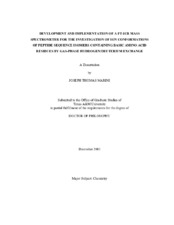| dc.contributor.advisor | Russell, David H. | |
| dc.creator | Marini, Joseph Thomas | |
| dc.date.accessioned | 2004-09-30T01:42:43Z | |
| dc.date.available | 2004-09-30T01:42:43Z | |
| dc.date.created | 2003-12 | |
| dc.date.issued | 2004-09-30 | |
| dc.identifier.uri | https://hdl.handle.net/1969.1/115 | |
| dc.description.abstract | The gas-phase hydrogen/deuterium (H/D) exchange of protonated di- and tripeptides containing a basic amino acid residue has been studied with a Fourier transform ion cyclotron resonance (FT-ICR) mass spectrometer. Bimolecular reactions are monitored as a function of time providing exchange efficiencies and temporal distributions for the peptide ions. Results from these experiments indicated that position of the basic residue within the peptide (i.e. N-terminal, internal, or C-terminal) influences gas-phase H/D exchange, suggesting unique peptide ion conformations. The FT-ICR mass spectrometer employed for these gas-phase H/D exchange studies was modified from its original design. Instrument modifications include development of an internal matrix assisted laser desorption ionization (MALDI) source for peptide protonation. In addition, a two-section cell was utilized, allowing control of ion motion and factors affecting gas-phase ion molecule reactions. Systems investigated in these gas-phase H/D exchange studies are peptides containing the same amino acid residues but different sequences. These sequence isomers display dissimilar reaction efficiencies and temporal distributions for deuterium incorporation depending on the primary structure of the peptide ion. Specifically, [M+H]+ peptide ions containing a N-terminal basic residue demonstrate unique H/D exchange behavior when compared to their internal and C-terminal counterparts. These differences are attributed to dissimilar intramolecular bridging interactions involved with inductive stabilization of the charge site. Gas-phase H/D exchange of peptide sequence isomers was also probed with various deuterium reagents. Findings suggest that different reagents also influence H/D exchange reaction rate efficiencies and temporal distributions. These dissimilarities are ascribed to relative gas-phase basicity and proposed mechanistic exchange differences for the deuterium reagents. | en |
| dc.format.extent | 11296820 bytes | en |
| dc.format.extent | 189983 bytes | en |
| dc.format.medium | electronic | en |
| dc.format.mimetype | application/pdf | |
| dc.format.mimetype | text/plain | |
| dc.language.iso | en_US | |
| dc.publisher | Texas A&M University | |
| dc.subject | H/D Exchange | en |
| dc.subject | FT-ICR | en |
| dc.subject | mass spectrometry | en |
| dc.subject | basic amino acid residue | en |
| dc.subject | oligopeptide | en |
| dc.subject | conformations | en |
| dc.title | Development and implementation of a FT-ICR mass spectrometer for the investigation of ion conformations of peptide sequence isomers containing basic amino acid residues by gas-phase hydrogen/deuterium exchange | en |
| dc.type | Book | en |
| dc.type | Thesis | en |
| thesis.degree.department | Chemistry | en |
| thesis.degree.discipline | Chemistry | en |
| thesis.degree.grantor | Texas A&M University | en |
| thesis.degree.name | Doctor of Philosophy | en |
| thesis.degree.level | Doctoral | en |
| dc.contributor.committeeMember | Singleton, Daniel A. | |
| dc.contributor.committeeMember | LiWang, Andy C. | |
| dc.contributor.committeeMember | North, Simon W. | |
| dc.type.genre | Electronic Dissertation | en |
| dc.type.material | text | en |
| dc.format.digitalOrigin | born digital | en |


